Does Skin Cancer Change Color When Pressed
The sooner a skin cancer is identified and treated, the improve your chance of avoiding surgery or, in the case of a serious melanoma or other skin cancer, potential disfigurement or even death.
Information technology is also a good idea to talk to your doctor nigh your level of risk and for advice on early detection.
Information technology'southward important to become to know your skin and what is normal for y'all, and then that you notice any changes. Peel cancers rarely hurt and are much more oftentimes seen than felt.
Develop a regular habit of checking your peel for new spots and changes to existing freckles or moles.
How to check your skin
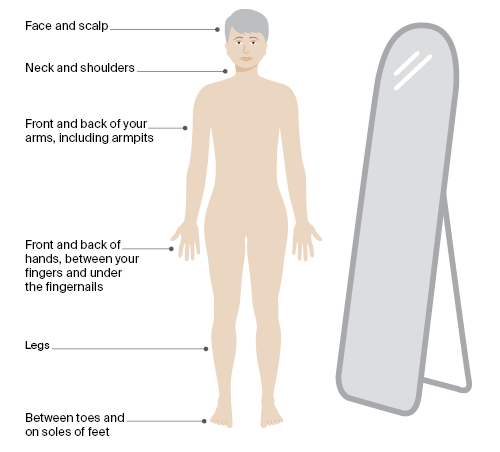
- Make sure you check your unabridged body, as skin cancers tin sometimes occur on parts of the body that are not exposed to the sun, such equally the soles of the feet, between fingers and toes and under nails.
- Undress completely and make certain you have skillful low-cal.
- Utilize a mirror to check hard to see spots, like your back and scalp, or become a family member, partner or friend to check for you.
What to expect for
There are three master types of pare cancer: melanoma (including nodular melanoma), basal cell carcinoma and squamous cell carcinoma.
Melanoma
- Most deadly form of peel cancer
- If left untreated, it can spread to other parts of the body
- Appears equally a new spot or an existing spot that changes in color, size or shape
- Tin can appear on skin not unremarkably exposed to the sun.

Nodular melanoma
- Grows apace
- Looks unlike from common melanomas. Raised and even in color
- Many are reddish or pinkish; some are chocolate-brown or black
- They are business firm to impact and dome-shaped
- Afterward a while, they begin to bleed and crust.
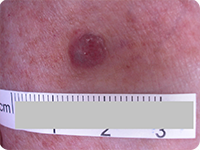

Basal jail cell carcinoma
- Most common, least dangerous form of peel cancer.
- Scarlet, pale or pearly in colour, appears equally a lump or dry, scaly area.
- May ulcerate or fail to completely heal.
- Grows slowly, normally on areas that are oftentimes exposed to the sun.

Squamous cell carcinoma
- A thickened, cherry scaly spot that may bleed easily, crust or ulcerate.
- Grows over some months, usually on areas often exposed to the dominicus.
- More than probable to occur in people over 50 years of age.
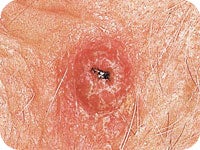
The ABCDE of melanoma detection can be a useful guide when checking your skin.
ABCDE melanoma detection guide
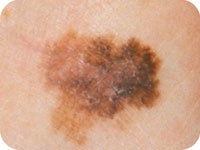
A is for Disproportion
Look for spots that lack symmetry. That is, if a line was drawn through the centre, the ii sides would not friction match up.

B is for Border
A spot with a spreading or irregular border (notched).
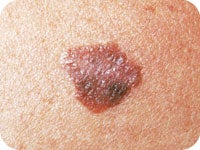
C is for Color
Blotchy spots with a number of colours such equally black, bluish, red, white and/or gray.
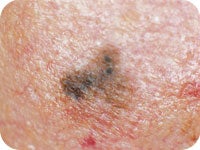
D is for Diameter
Expect for spots that are getting bigger.

Eastward is for Evolving
Spots that are changing and growing.
Epitome: © The Academy of Sydney, reproduced with permission
Photos courtesy of Prof John Kelly FACD and the Australasian Higher of Dermatologists.
These are some changes to look out for when checking your pare for signs of any cancer:
- New moles.
- Moles that increases in size.
- An outline of a mole that becomes notched.
- A spot that changes color from brownish to black or is varied.
- A spot that becomes raised or develops a lump inside it.
- The surface of a mole becoming rough, scaly or ulcerated.
- Moles that crawling or tingle.
- Moles that bleed or cry.
- Spots that wait dissimilar from the others.
Mole or skin cancer?
Almost all of us have moles. Moles are not normally present at birth, just appear in childhood and early teenage years. By the age of 15, Australian children take an average of more than than 50 moles.
Normal moles usually look alike. Run across your doctor if a mole looks different or if a new mole appears after the age of 25. The more moles a person has, the higher the take a chance of melanoma.
- Moles are harmless coloured spots that range from 1 mm to 10 mm.
- They are uniform in shape and even coloured. They may be raised.
- The more moles or freckles you accept, the higher your chance of peel cancer.
- Moles may accept uneven borders and multiple colours similar brown and black.
Observe moles carefully for any sign of change. Although you may notice one or more skin changes, it does non necessarily mean that you have peel cancer, however it is important that you visit your GP to accept them investigated further. Your GP tin can discuss your skin cancer take chances and advise you on your need for medical checks or self-examination.
Information technology can be hard to know whether something on your skin is a harmless mole or normal lord's day harm, or a sign of cancer. When in doubt, speak to your GP.
What is my peel type?
Peel types that are more sensitive to ultraviolet (UV) radiation burn more chop-chop and are at a greater gamble of skin cancer.
All skin types can exist damaged by too much UV radiation. Pare types that are more sensitive to UV radiations burn more quickly and are at a greater take a chance of skin cancer.
People with naturally very night skin (usually pare type V or Six) still need to take care in the sunday even though they may rarely, if e'er, go sunburnt. The larger corporeality of melanin in very dark skin provides natural protection from UV radiation. This means the take a chance of pare cancer is lower.
Eye impairment can occur regardless of skin type. High levels of UV radiation have besides been linked to harmful furnishings on the immune system.
Vitamin D deficiency may be a greater health business for people with naturally very dark skin, as it is more difficult for people with this peel type to make vitamin D.
Skin types
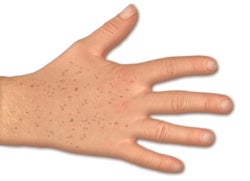
Type I
Often burns, rarely tans. Tends to have freckles, scarlet or fair hair, bluish or green eyes.
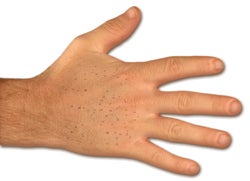
Type II
Usually burns, sometimes tans. Tends to have light hair, blueish or brown eyes.

Type III
Sometimes burns, commonly tans. Tends to have brown hair and eyes.
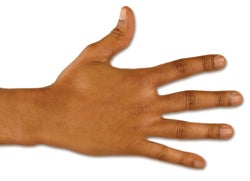
Type Iv
Rarely burns, often tans. Tends to accept dark brownish eyes and hair.
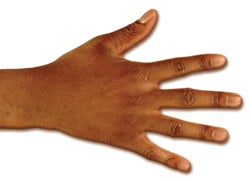
Type V
Dark brown peel. Rarely burns, tans profusely.
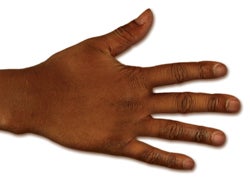
Type Half-dozen
Deeply pigmented, dark brown to black skin. Never burns.
Cancer Council Australia would like to thank Cancer Research UK for the provision of these skin type images.
Source: https://www.cancer.org.au/cancer-information/causes-and-prevention/sun-safety/check-for-signs-of-skin-cancer
Posted by: simpsonpladowithe.blogspot.com

0 Response to "Does Skin Cancer Change Color When Pressed"
Post a Comment